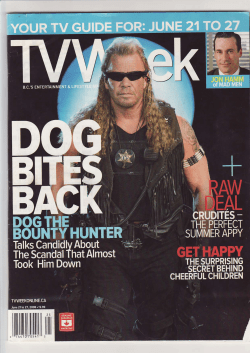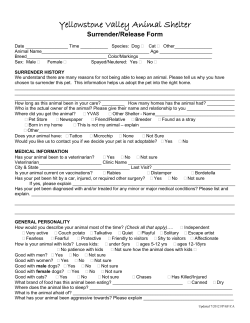
7 s i n g a p o r e
s i n g a p o r e 7 Learning How to Deal with Your Fearful Dog 12 “The Horrendous Conditions of Puppy-Mills Are Definitely Not for the Faint-Hearted” MCI(P) 118/07/2013 April - June 2013 APRIL - JUNE 2013 03 Letter from Corinne 04 In & Around SPCA 07 Training Tips With Nee! 09 Animal Rescues 10 Inspectorate 12 Cover Story : How Much IS That Doggy In The Window ? 16 Features : So You Want To Be A SPCA Foster Parent ? 20 International News 23 Three Minutes In Their Shoes 24 Happy Ever After We welcome contributions to the SPCA Bulletin. Send them to the Editor, no later than 10 September 2013. The next issue is due October 2013 Sheena Conceicao spcabulletin 1 LETTER FROM CORINNE Research is vital if you are planning to add a puppy to your family. We’ve exposed the grim realities of puppy mills and unlicensed breeders and the media has reported on heart-breaking stories of owners duped into buying unhealthy pups. Lately, we know of several puppy mills that have shut, causing unwanted and undesired male and female dogs bred to the point of exhaustion and past their prime, to be thrust out like old rags. We want to raise awareness of the insidious dirty business that goes on right under our very noses. And we continue to lobby for better protection for these animals and against the breeders who neglect and abuse their animals. The SPCA continues to speak up against puppy mills and unlicensed breeders and the deplorable state of their breeding facilities. In our Cover Story, Ann Lek gives a lowdown on what exactly goes on behind the scenes of a puppy mill, and how these facilities are never shown or known to a consumer who buys the cute puppy behind a window display panel of a pet shop. We’re not down with puppy mills and the unlicensed breeders. And if you do bring a new pup home to your family, Dr Kang Nee, a certified professional dog trainer and behaviourist, gives you tips on how to teach your fearful dog to cope with its anxieties. We’ve had many volunteers helping us this past quarter, most notably volunteers from the Ministry of Foreign Affairs and National Parks Board. We thank them for their time and effort and we hope to see them again real soon. Last but not least, the SPCA will hold its Gala Dinner on Saturday September 28, 2013 at the Conrad Centennial Singapore. Entitled, “A Benefit Night for Animals” our Gala Dinner’s objective is to raise funds for our new building. Our lease on Mount Vernon Road runs out in 2014, and we are expected to occupy our new premises by December 2014. If you yet haven’t bought tickets to the dinner, it’s not too late. I hope to see you there. If your business is interested in offering SPCA Membership membership@spca.org.sg Sincerely, Corinne Fong Executive Director, SPCA spcabulletin 3 Fearful Fifi and Growly Gus – What Makes Your Dog Afraid By Nee Kang, cheerfuldogs.com Nee is a certified professional dog trainer with a PhD in Zoology. Even whilst busy training dogs, she writes articles on dog behaviour modification and training for local and international magazines. website: www.cheerfuldogs.com; email: kangnee999@yahoo.com; facebook: https://www.facebook.com/kang.nee.9 “Canine Education @ SPCA” is a programme developed by Nee Kang of cheerfuldogs.com and SPCA Singapore to provide information about dog behaviour and training. In this installment of an on-going series, we look at what makes a dog afraid, and how we can help it cope with its fears. When a dog snaps at you, or shrinks away from your well-meaning touch, it is telling you something, “Please stop! You’re making me afraid.” A dog can be afraid of many things or being in different situations. It can be neophobic (afraid of new things or changes); it can be noise-reactive1 or afraid of thunderstorms; it can be afraid of children, men, people wearing certain articles of clothing (e.g. sunglasses, dark clothes); it can be reactive towards another dog or animal, and it can also be afraid when we encroach upon its personal space, e.g. it guards food, toys, or reacts when you try to touch it on some part of its body2. When a dog is afraid, it is under a high level of stress and that stress can prompt it to either flee or fight. Sometimes it will flee, at other times, when it is pushed beyond its limits of stress tolerance, it will fight. Most dog bites and aggression stems from fear as the underlying cause. To help a “Fearful Fifi” or “Growly Gus”, we need to understand what makes a dog afraid. A dog that is afraid is not being disobedient - when it snaps when you reach for its food bowl, or it reacts to another dog, or when it panics in a thunderstorm. A puppy goes through three critical developmental periods in the first three to four months of its life: (a) it learns whether situations it encounters are safe or unsafe – the fear period; (b) it learns how to be confident – the socialisation period; and (c) it learns to bond with its human family – the bonding period. If at any time during this critical period, a puppy was overwhelmed by a situation it encountered, it can learn to be fearful or reactive. Example: a puppy flinches when you pat its head. A good trainer, recognising the puppy’s signals of stress, would handle the puppy over many short sessions, always making sure that each experience is safe, positive and enjoyable for the puppy. We would not handle the puppy vigorously for prolonged periods, thinking that the more the puppy is handled, the more comfortable it will become. Often it will not. Similarly, while we want our dog to get along with other dogs, bringing it to a dog run and letting it work its way through a crowd of unfamiliar dogs may not be appropriate. Proper socialisation involves staging a series of well-managed interaction sessions where a naïve dog is introduced positively to non-reactive dogs without getting overwhelmed, hence learning that spcabulletin 7 being with another dog is safe, enjoyable and more importantly, all dogs can remain calm. As a dog grows older, it may become fearful towards situations that it had been fine with in the past. Again, the key is to recognise that your dog is not being deliberately disobedient – it is sending you a signal for help, in the only way it knows how. How then, can we help our “Fearful Fifi” and “Growly Gus”? (1) Seek the help of a professional and qualified behaviourist or trainer who can guide you in reading your dog’s body language so that you can tell if your dog is stressed; (2) Embark on a proper behaviour modification protocol with your trainer that uses positive reinforcement, non-aversive, force-free training methods. Choke chains, prong collars, shock collars and punishment have no place in helping a dog that is afraid or reactive. It is no longer in the realm of conjecture – using force can escalate reactivity; (3) Be committed, patient and understand that it will take time working in incremental steps to help your dog overcome its fears. Reducing stress is the top priority; management such that you avoid putting your dog in situations that have triggered fear or aggression is another; and following the behaviour modification protocol are all ingredients to success when we help our dog learn that something ‘bad’, can become something ‘better’ or even ‘good’, or ‘wonderful’. Just as you would have special programmes to help a child with ADHD learn safely, so too, would you help your dog in an equivalent way. Tips for Helping a Mildly Fearful Dog If a dog shrinks away when you walk towards it, but will come forward and eat something when you walk away, you can start the first step of helping it learn that you are safe. • • • • • • Carry pea-sized pieces of yummy food with you Find that distance at which you can be, and the dog does not shrink away, e.g. 10m Staying at 10m or even 12m away, walk calmly past the dog. Do not approach head-on. Instead, walk in a curved path away from the dog. Avoid making direct eye contact with the dog at all times As you pass the dog, gently and calmly toss a piece of yummy food on the ground near it. It does not have to be in front of the dog – it can be beside, in front or behind the dog. The purpose is not to lure your dog forward towards you, but rather, to make the following association for the dog: that when someone comes by, something good happens. Better still, the object of fear (the person) goes away too! Do this as often as you can, until you see the dog beginning to anticipate your approach in a more relaxed manner Continue to work with your behaviourist or trainer on the next step of the behaviour modification programme 1. Nee Kang & Jeffrey Lee (2013): The Midnight Snack: Helping Kiyo Cope with 'Things That Go Bump In The Night' in a High-Rise Apartment Living Situation. The APDT Chronicle of the Dog, Spring 2013. 2. Nee Kang & Jeffrey Lee (2013): Creating a Positive Conditioned Emotional Response - Putting the 'Good' into Something 'Bad'. The APDT Chronicle of the Dog, Summer 2013. Both articles can be read for free at http://www.cheerfuldogs.com/trainingtips.html ~ Contact Nee at kangnee999@yahoo.com about training for your dog. ~ spcabulletin 8
© Copyright 2025









